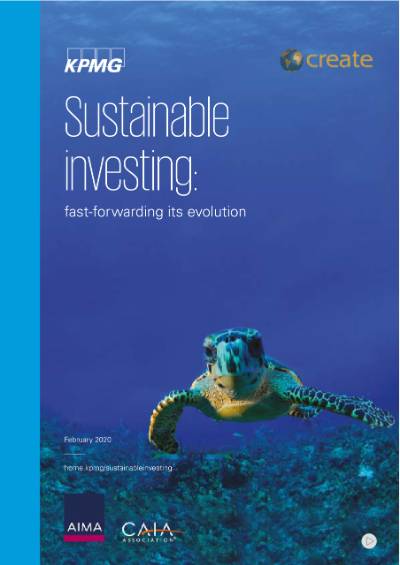Three key issues
In the last decade, various governments worldwide have enacted over 500 new measures to promote environmental, social and governance issues (ESG). Given the magnitude of the task, various players are involved: governments, regulators, capital markets, businesses and consumers; and they are aided and abetted by green technologies and business model innovations.
KPMG International, CREATE-Research, AIMA and CAIA Association, examine in detail sustainability investing and its impact on the alternative investment industry. The research includes insights from 135 institutional investors, hedge fund managers, long only managers and pension consultants in 13 countries in all the key regions.
The research highlights the lessons learned, exploring three key issues.
- What is the current state of progress in implementing sustainable investing?
- Why is the pace of progress being held back by various barriers?
- How are these barriers being tackled on the ground by evolving best practice?


Hedge fund managers’ survey — Key data points
Institutional investors are the biggest driver of demand for ESG-oriented hedge funds
ESG-oriented hedge funds continue to target alpha returns, while managing fat-tailed far‑off risks
Hedge fund managers have embedded ESG factors across their strategies
Progress hampered by lack of robust templates, consistent definitions and reliable data
ESG is no longer a nice‑to-have; it’s a must‑have.
Case study
ESG as a risk management tool As fiduciaries, we look at anything that may materially affect the financial returns of our funds. We believe that ESG factors clearly belong in this conversation, particularly as a risk mitigate. While we recognize that the ESG data out there can be very noisy, we have found success by combining fundamental analysis with select data sources to create a more holistic picture about each investment in our portfolio. This picture allows us to more proactively identify and monitor risks, both before and after an investment is made. This is by no means easy to do, but we do think there are material signals out there waiting to be found for investors willing to do the work. At the end of the day, ESG factors should be treated just like other risk factors. With more and more of a company’s value now tied up in so called 'intangible assets' like brand recognition and goodwill, it seems inevitable that ESG components like employee diversity and environmental stewardship will take on increased importance in future investment. - A European fund of hedge funds |
Institutional investors’ survey — Key data points
ESG-oriented hedge funds can deliver alpha and also manage fat-tailed far-off risks
ESG is material to the financial performance of investee companies
Too early to decide whether sustainable investing delivers double bottom-line outcomes
Lack of consistent quality data is a challenge in the adoption process
We see growing evidence of immediate or short-term value creation in sustainability rather than just long‑term.
Case study
Embedding ESG into corporate DNA We look for hedge fund managers that clearly have ESG in their DNA. We evaluate these managers for how well they integrate it into their research and investment processes, how committed they are to responsible ownership, and the quality of their approach to sustainability data and nonfinancial reporting. An ESG policy is the absolute bare minimum and it is not usually enough to earn a recommendation from us. We also want hedge fund managers to show that they are willing to ‘walk the walk’ of ESG by asking themselves the same sorts of questions that they would ask of portfolio companies. That means a hedge fund should have a commitment to employee diversity, equitable pay, appropriate fees and fund structures, and strong corporate governance. If a hedge fund truly believes in ESG as part of its core investment philosophy, then it follows that it should be seamlessly integrated across the organization. - An institutional consultant |
Early adopters narrative — Key data points
Future success critically hinges on three factors: a new model of shareholder engagement that enjoins investors to go from distant owners to vocal change agents; savvy implementation of sustainability into investment portfolios; and business leadership that is keen to capitalize on the opportunities arising from the transition.
- Markets are slow to price in sustainability risks due to their excessive focus on short-termism
- A new infrastructure of skills, data and technology is creating tailwinds for sustainable investing
- Active Ownership 2.0 is emerging as the best practice model for effective engagement
- Savvy implementation of sustainability factors is vital for achieving the expected outcomes
With governments, regulators, asset owners and asset managers seeming to pull in the same direction, it is hard to believe that we are not in the midst of something profound.
Case study
Sustainability a risk factor? The rise of sustainability has naturally raised the question: is it a risk factor — on top of the traditional ones like value, quality, low variance, size and momentum? The main problem is that most risk factors are not readily observable. So, our portfolio managers are forced to use their proxies. For example, value factor is associated with cheap stocks. But the evaluation of ‘cheap’ relies on metrics such as book‑to-price or PE ratios. In contrast, as yet, there is no agreement on the proxy metrics for environment, social and governance; nor on what weights to assign to each of them. Traditional risk factors have gained credence over time as more data have emerged to confirm their validity. In contrast, being a relatively new phenomenon, sustainability lacks the database to underpin its status as a risk factor. But that does not make it unimportant. First, there is a concerted regulatory push towards sustainability, as investors have earmarked some US$30 trillion worldwide towards sustainable investments. It is hard to believe markets will not take note. Second, the history of other risk factors shows that, once discovered, they remain uncompensated until they have been tried and tested by events. We have been witnessing dramatic climate events in this century as well as related high-profile corporate disasters — like the recent abrupt bankruptcy of Pacific Gas and Electric Company. So, sustainability is gradually transitioning from being an uncompensated risk factor to a compensated one. Third, our own research shows that sustainability is correlated with the traditional quality factor that relies on proxies that are broadly similar. Even so, we use sustainability as a factor to deliver — at the very least — a more defensive portfolio by taking account of long horizon risks that are statistically hard to model. - A global French asset manager |
Takeaways
The challenges identified are the teething problems of a better form of investing. Sustainability is set to morph into the new gold standard, as our societies seek to overcome the side effects of the turbocharged capitalism of the past 40 years. Before then, sustainability is beset by its own challenges. But early movers see it as no more than a concealed opportunity to create businesses of enduring value — and profit from them.
Institutional factors are fast driving change. Pragmatism has been all too evident, with concerted action now in progress. There is an increasing realization that finance must give something back to society as well as making profit. Early results are encouraging.
Only responsible ownership and savvy implementation will deliver sustainability. They will also differentiate the winners from the losers.




